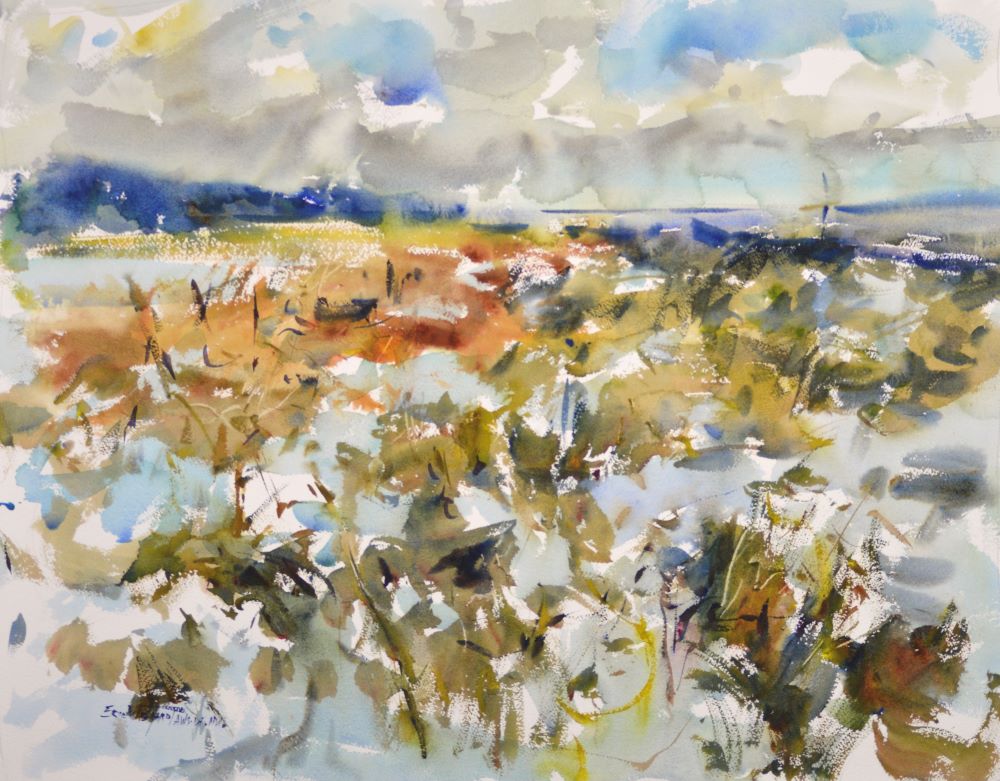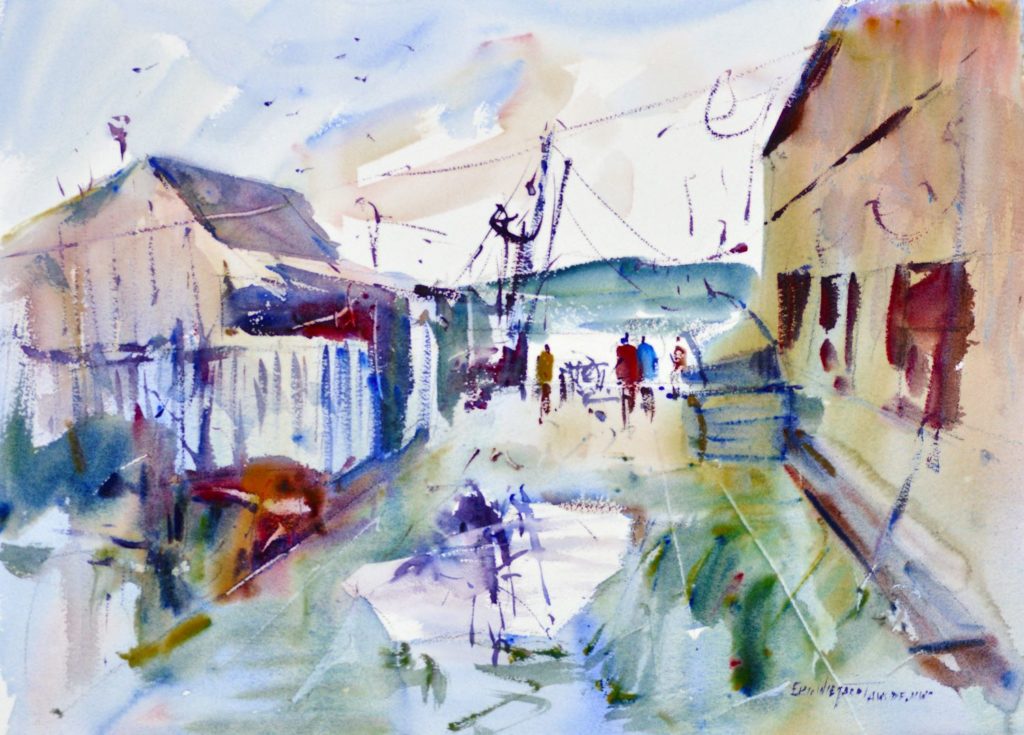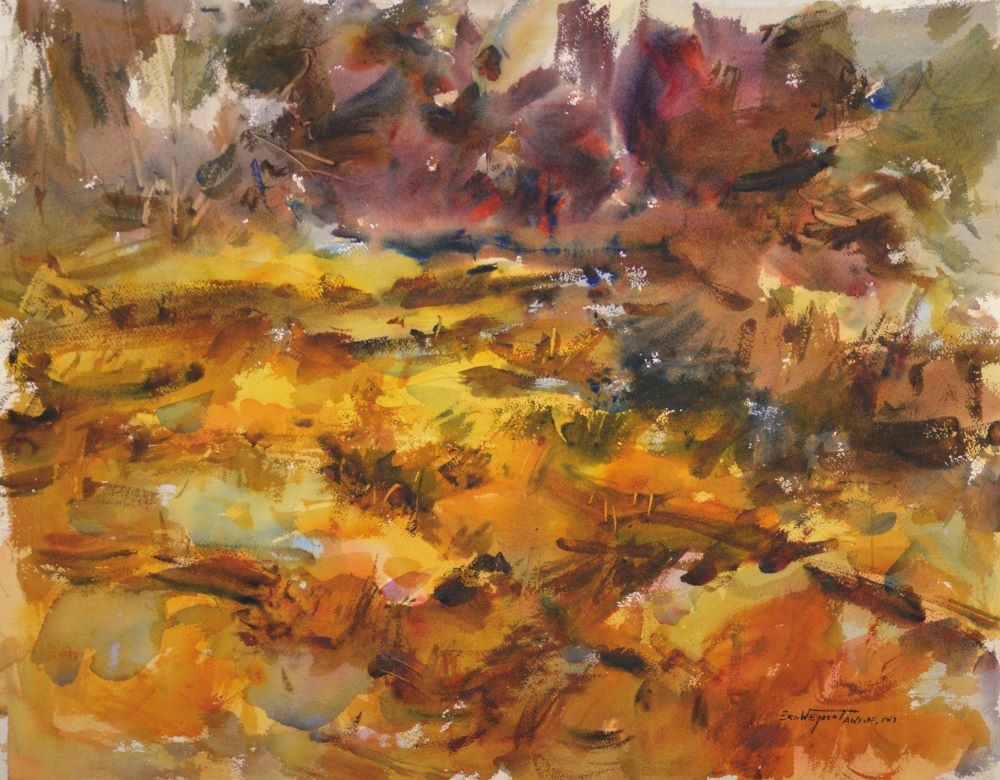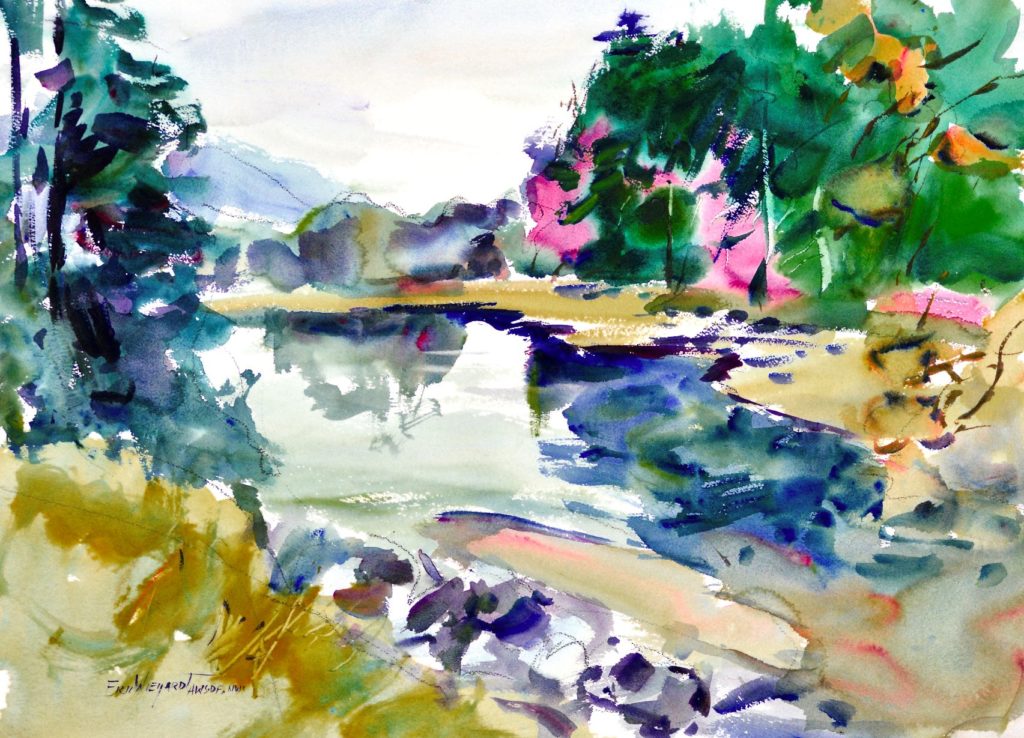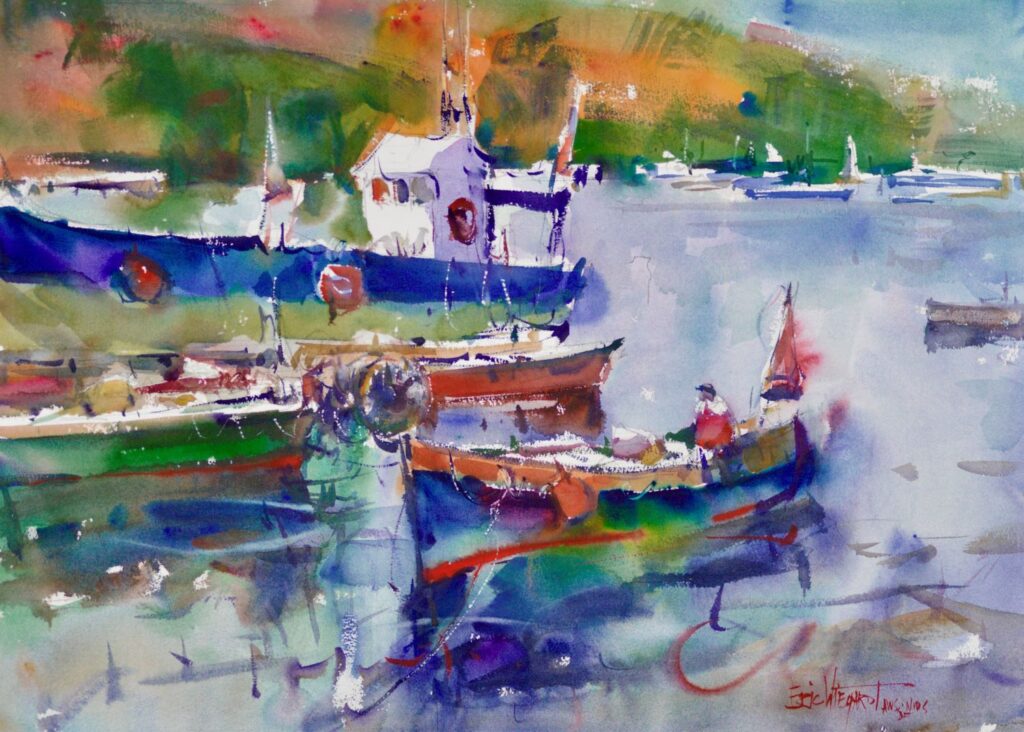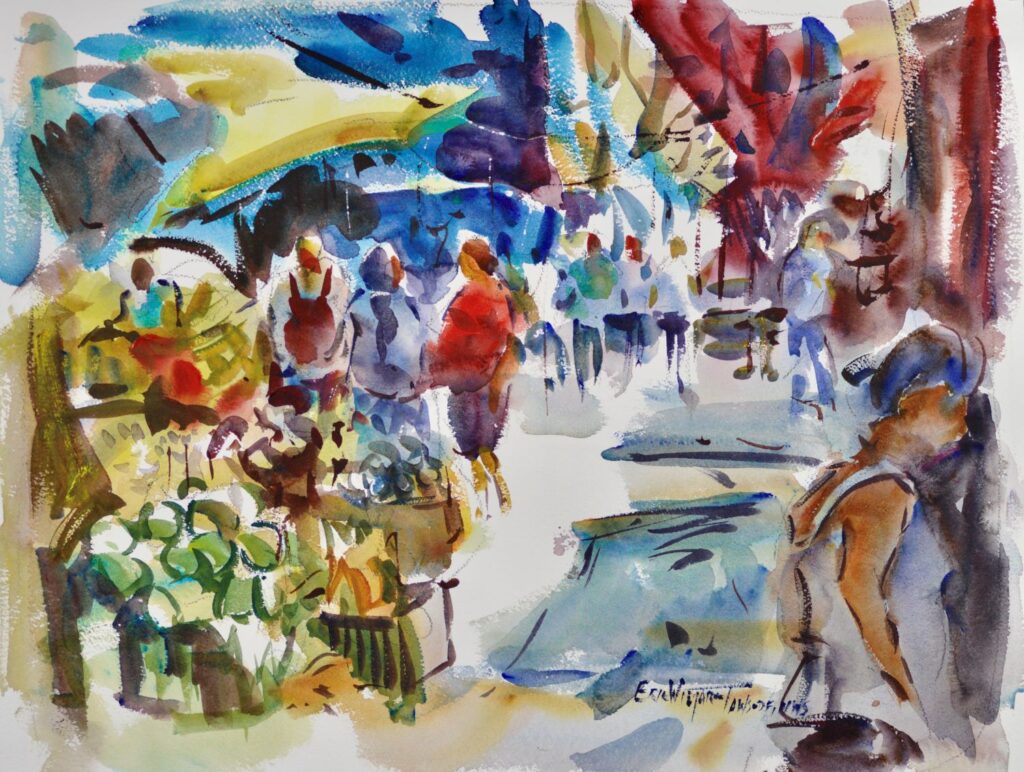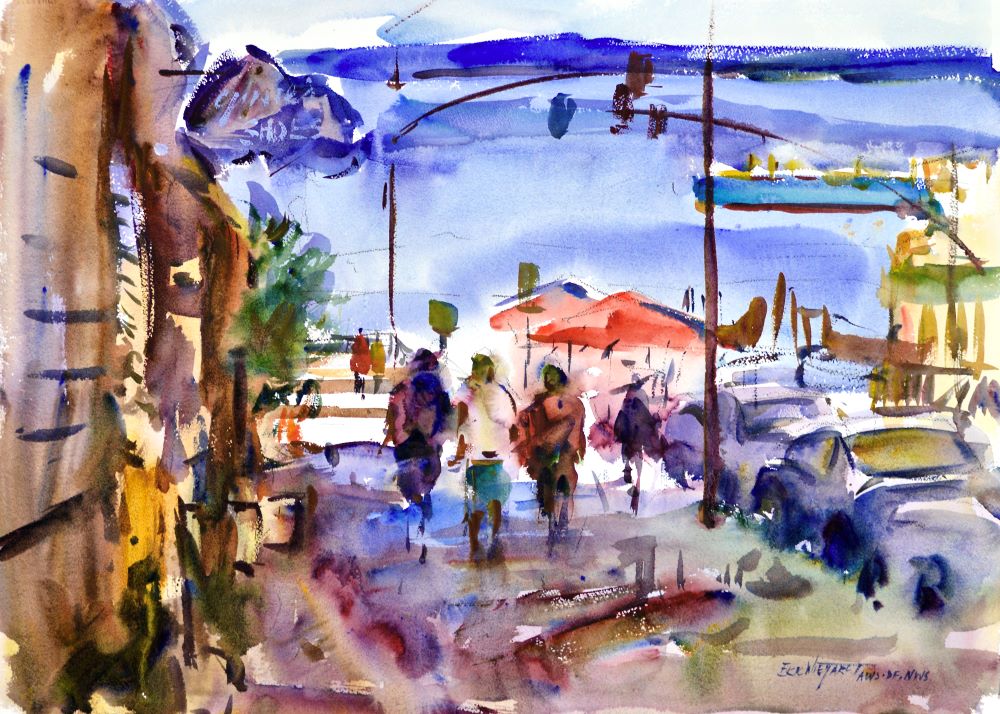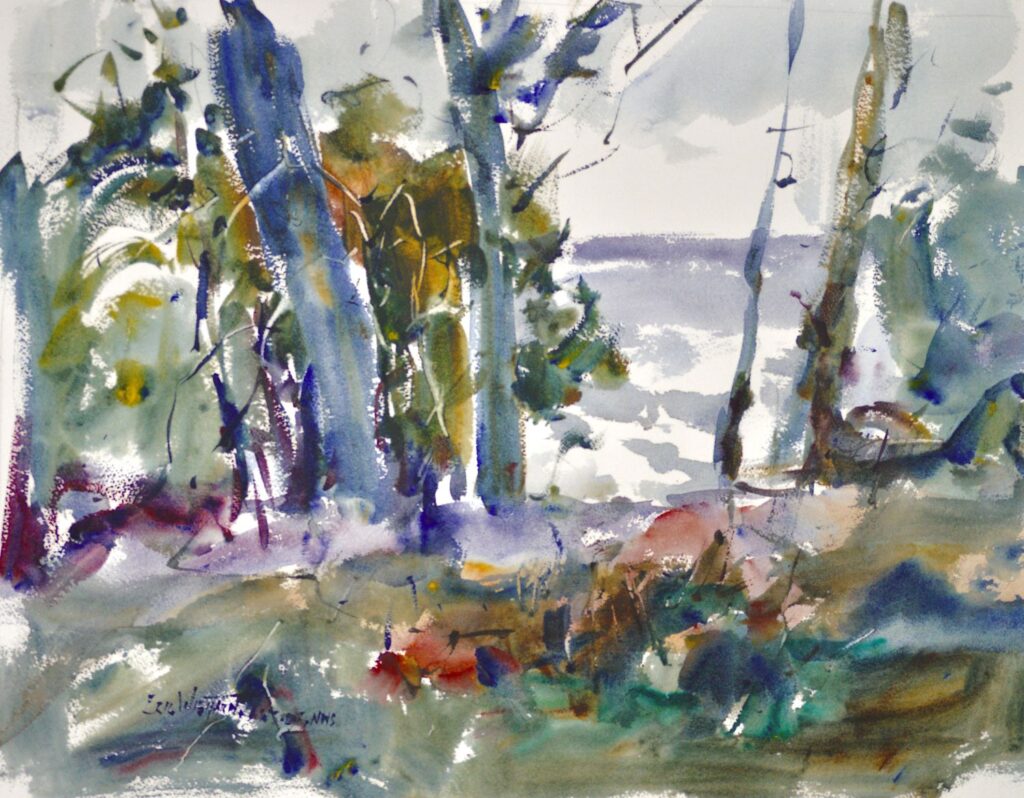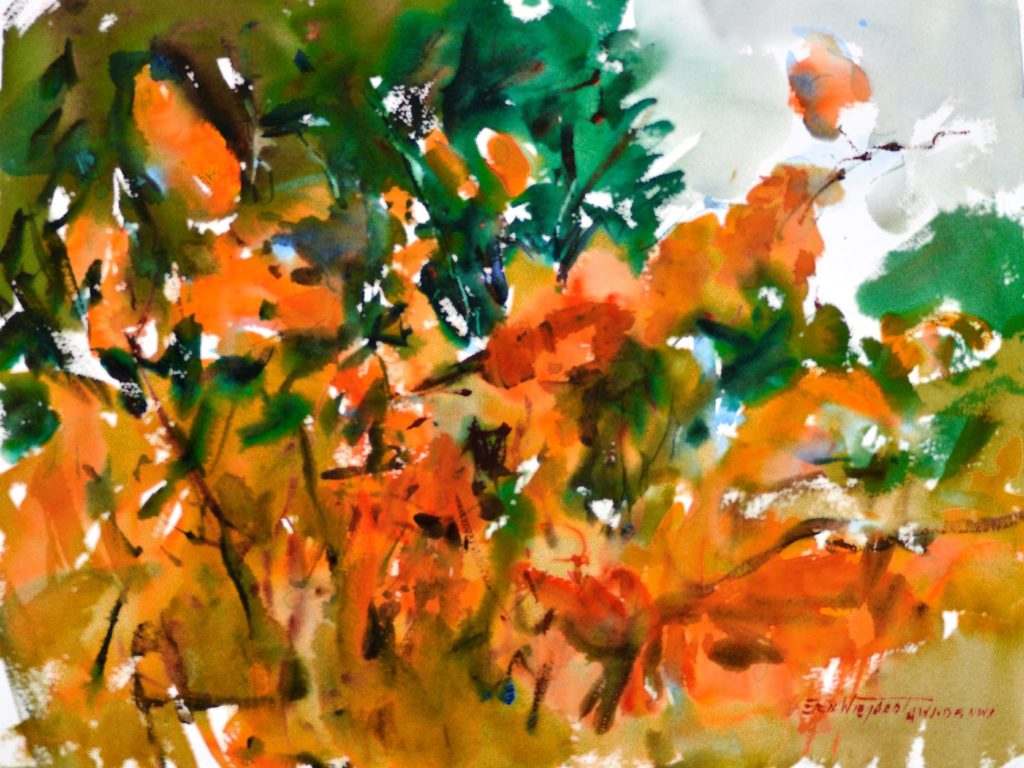Message from Eric
2023 Messages from Eric:
Eric shares his expertise and insights into watercolor painting to help you grow as an artist and find your own style. He will happily address any of your questions and talk about his own experiences gained since he started on this journey over 30 years ago.
A new article is published every month. You can also sign up to receive MESSAGE FROM ERIC as part of our Artists Newsletter HERE.
If you have a question that you would like Eric to answer, just send it to wiegardtwatercolors@gmail.com with “Message from Eric” in the subject line.
January 2023
Color: A Balancing Act
Suppose my painting is coming along just fine and midway through the process my intuition tells me to do something completely different. I introduce a fairly intense color, maybe Phthalo Green, on the right-hand side of the painting. Knowing that instinctive strokes arise from unconscious creative thinking, I want to capitalize on the stroke of green.
How do I balance the rest of the painting with this isolated color statement?
You might suggest I place other Phthalo Green strokes throughout the painting. This answer would not be wrong. But remember, the objective is to mitigate the strong statement of Phthalo Green so that the eye will not be locked onto its intense color. The goal is NOT to balance color throughout the painting.
Let’s consider other tools to bring the viewer’s eye back to our area of dominance. Harder edges, stronger value contrasts, more detail and texture, a figure, and line work can all help to direct the eye back to the focal point. So don’t be afraid to let your intuition take over.
Keep your brush wet,
Eric
February 2023
Area of Dominance
Here is how I go about creating an area of dominance.
First, I block in my large shapes by establishing their appropriate value. I paint large connecting patterns with soft edges. These are easy to tighten up later.
Next, I begin to elevate my area of dominance. I do this by constructing sharper value contrasts, using warmer colors, harder edges and more detail.
Then I work on the rest of the painting, being careful not to make it more refined than the area of dominance.
After that I return to the area of dominance, bringing it to a higher level of completion. Then I go back to work on the supporting areas of the painting again. I follow this stair-step procedure throughout the painting process to completion. By always keeping my area of dominance ahead of the rest of the painting, I ensure that it controls the overall design.
See my video #6: Area of Dominance
Keep your brush wet,
Eric
March 2023
DRAWING MADE EASIER
Translating a drawing from a small value sketch to a large sheet of watercolor paper can be daunting. If we’re not careful we can end up with a drawing that is too small for the paper. Here are some techniques that work well for me.
Stand away from the paper at arm’s length. This way you can see the whole paper and the spatial relationship of all the shapes to each other.
Hold the pencil loosely with the arm near full extension. Drawing from the shoulder rather than the wrist gives you more control, allowing you to establish broad, sweeping relationships.
As the drawing progresses, keep checking all the relationships to each other. I call this triangulating. I will pause, for example, with my pencil on the paper at the corner of the boat cabin and draw mental lines to other important points already sketched in. My eye quickly checks the angles and distances to make sure the proportions are correct.
I hope these suggestions make sketching less challenging.
Keep your brush wet,
Eric
April 2023
HOW TO PAINT LOOSELY–BOLD COLOR
There are several important design principles behind my loose painting style. One of these is to use lots of water and fresh pigment. I will stack several layers of color, one on top of the other, on my brush. Then, with very little mixing, I apply a bold band of rich juxtaposed colors in one stroke. This technique requires plenty of fresh color squeezed onto the palette, as well as decisive brush handling with minimal mixing and stroking. The small bands of broken, complementary color within a single stroke add to the fresh, loose, bold color statement.
My Painting Loosely DVD is a good introduction to this style of painting.
Keep your brush wet,
Eric
jUNE 2023
Combining Shapes
Painting loosely doesn’t simply mean doing what comes naturally. Done well, it requires following some important principles. One of these is the idea of combining two adjacent shapes of similar value into one larger, more interesting shape–something that looks more like a puzzle piece than a simple geometric shape. When painting a boat, for example, I don’t separate the dark hull from its dark reflection. Instead, I paint through the waterline and create one new shape with no separation. These big shapes allow for passages of flowing color and bold brushwork. The effect of reflected color is an additional benefit of this approach. And the soft edges created are easy to tighten up later with a firm stroke, if desired.
My books and videos elaborate on each of the key design concepts behind painting loosely. My weekly Zoom mentoring classes focus on principles of composition as well. May you find these tools helpful as you continue on your artistic journey.
Keep your brush wet,
Eric
PS: See my Connecting Shapes DVD #1
July 2023
Mixing Colors
Want to avoid muddy watercolors? It’s surprisingly easy with the right materials, knowledge and practice. I’ve found the best materials are my favorite palette propped at a slight angle, my favorite brushes, and pigments that have the consistency of sour cream. Remember to use plenty of pigment. This is key for getting bold color on the paper. Finally, don’t overmix the colors. Load the tip of your brush with freshly squeezed tube pigments, move the brush in an ‘S’ or ‘8’ on the palette. Then scoop up some water and apply to the paper. Watch me demonstrate these techniques in my Streaming Video #2 ‘Mixing Colors’.
My books and videos elaborate on each of the key design concepts behind painting loosely. My weekly Zoom mentoring classes focus on principles of composition as well. May you find these tools helpful as you continue on your artistic journey.
Keep your brush wet,
Eric
August 2023
Color Mixing
Want to avoid muddy watercolors? It’s surprisingly easy with the right materials, knowledge and practice. I’ve found the best materials are my favorite palette propped at a slight angle, my favorite brushes, and pigments that have the consistency of sour cream. Remember to use plenty of pigment. This is key for getting bold color on the paper. Finally, don’t overmix the colors. Load the tip of your brush with freshly squeezed tube pigments, move the brush in an ‘S’ or ‘8’ on the palette. Then scoop up some water and apply to the paper. Watch me demonstrate these techniques in my Streaming Video #2 ‘Mixing Colors’.
My books and videos elaborate on each of the key design concepts behind painting loosely. My weekly Zoom mentoring classes focus on principles of composition as well. May you find these tools helpful as you continue on your artistic journey.
Keep your brush wet,
Eric
September 2023
Landscape Theory
This month I would like us to think about what happens when we go out and look at the landscape. How does the sun affect color we see? How do we represent that? How do we give dimension and life to our paintings?
It begins with choosing the correct color value shifts for large key elements. These key elements generally consist of sky, hills, ground and trees. These need to be represented lightest to darkest. The sun causes the sky to be lightest, ground second lightest, hills darker and finally trees will be darkest. This value scale needs to be carefully chosen. If the colors are too close in value your painting will appear flat and lifeless. You may also find elements oddly floating.
Getting these values right means you can paint loosely and then add details. Most painting problems result from the violation of an elementary painting principle. Avoid this one and learn more by watching my videos on Landscape Theory, both streaming and on DVD.
Keep your brush wet,
Eric
October 2023
Outside Edge Shapes
This lesson was driven home many years ago in a plein air demonstration in Florida. I had lost my way painting palm trees. Their shape was so unfamiliar to me I focused on the inside of the tree instead of the outside edge. After I switched focus to the outside shape my palm started coming together. The lesson driven home that day: The character of the object is carried more by the careful construction of the outside edge of the shape rather than the delineation of interior detail. Detail is rarely the answer to our painting problems.
Accomplish this by using a simple flat wash and just a suggestion of texture and detail. Know that the outside dimensions will carry the character of the object. Then complete the picture, using bold, fluid brush statements within the shape for a loose effect. It may also be time to render the interior with more detail and more definition.
Learn more by watching my videos on ‘Outside Edge Shapes’, both streaming and on DVD.
Keep your brush wet,
Eric
November 2023
Area of Dominance
There are two strategies for creating an area of dominance that I use which work particularly well with watercolors. First, soft edges are much easier to work with than hard edges. A soft edge can easily be tightened up into a harder one by simply overlapping a crisp stroke over the underlying soft edge. This can create a beautiful painterly, loose stroke.
I often start painting on damp paper, encouraging soft edges throughout. This gives me much more flexibility in developing my painting. I won’t be caught in a corner with too many hard edges that need softening. Towards the end of painting I ensure a tight, hard edge or possibly several in the area of dominance and progressively construct fewer and fewer as I move to the outside.
Second, intense colors are easy to neutralize with successively grey washes. Grey washes that have dried are difficult to intensify. Therefore, I start out painting with a lot of intense color – more than I need – in anticipation of graying areas away from my area of dominance. Progressively larger passages will be neutralized as the eye moves away from the area of dominance.
Try to give your area of dominance a more powerful statement by simply backing off on the rest of your painting.
Keep your brush wet,
Eric
DECEMBER 2023
Christmas Greetings
This is our 38th year running Wiegardt Studio Gallery. Time flies! We are grateful to my folks for giving us the opportunity to establish our gallery here on the peninsula. We appreciate our employees who make our lives much easier. And we are so thankful to you for supporting our business over the years.
This was the first year we’ve spent Thanksgiving away from the Gallery. We had a wonderful time with all our kids and grandkids gathered in Bremerton. It was such a treat to have everyone together for the first time in several years.
We were blessed with two new grand babies this year: Evelyn Grace was born April 3 to Kelly and her husband John, who are in Los Angeles. Moses Zachary was born September 19. He lives in Bremerton with parents Nate and Tabi, and big sister Naomi, who is 3. Zach and Erin also live in Bremerton with Lizzie, age 3, and Theo who is 1. Esther and Ryan are in Spokane with Benjamin, 2 and Charlotte, 11 months.
We did a lot traveling in 2023. Workshops in Alaska, Hawaii and Arizona. The American Watercolor Society Show in New York City, where I was a judge. Visiting Kelly, John and baby Evelyn in Los Angeles. Plus visiting Spokane to see our family there. Our annual European trip included visits to Iceland, France and Switzerland for my plein air workshop.
We have exciting plans for more travel workshops in 2024. For now, we’re glad to be staying close to home, enjoying the holidays with loved ones.
Merry Christmas! We pray you will have a blessed time with your family and friends.
With gratitude,
Eric and Ann
